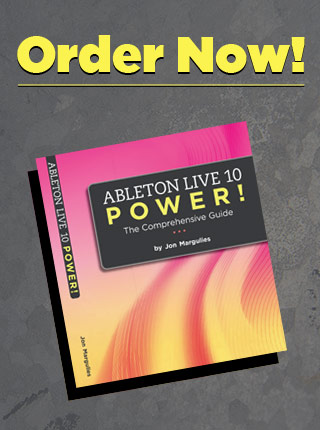When mixing, it’s really nice how easy Live makes it to A/B different effect settings or configurations – even when spread across multiple tracks. For example, earlier today I wanted to compare two different EQ settings on a layerd bass part. I wanted to hear what it sounded like to boost the lows in […]
SEE THE REAL FREEZE
Sometimes when editing a frozen track, it can be tricky to get the editing just right because you can’t really see what you’re editing. What you need to see is the actual waveform generated when the track is frozen, rather than the original audio or MIDI. The trick here is to display an automation lane, […]
EDIT GROUPS
Did you know that you can edit the clips inside Group tracks from the Group track itself? This is a feature that’s easy to miss because earlier versions of Live 8 (prior to 8.1, I think) didn’t work this way. Group tracks display colored bars to represent the Clips within: Selecting any portion of […]
TRANSPOSE VS. BASE
If you take a look at the Scale device, you’ll notice that right below the Base knob, there’s a Transpose control. And yet, I said you should use Base when changing the key of a preset scale… The difference is that Base simply transposes the scale, while Transpose will transpose each incoming note. Er, or […]
ONE SCALE, MANY MODES
Someone just asked me a question about creating custom Scale presets. Scale is used to force all incoming notes to conform to a particular scale. While the Scale’s interface is perfectly logical, it’s pretty tricky to wrap one’s head around. I’m not really going to get into explaining it except to say that it’s […]
PLACE THE CLIP, SWITCH THE SAMPLE
A few months back, I did a little series on creating audio files full of strange sounds, then getting them into your productions via Drum Racks. Today I was reminded of another way to work with glitchy goodness. Above you’ll see a sample placed directly into the timeline in a couple of spots. It’s from […]
GROUP IN A GROUP
Every now and then you’ll bump into the problem that you can’t have a Group track within a Group track (the way you can nest Racks within each other). For example, you might want to group a set of keyboard parts together, but one of the parts is made up of two tracks you’ve layered […]
GROUP THE EXTRACTED
Before you extract the Chains in your Drum Rack into separate chains, make a note of the volume of the track the Drum Rack is in: When you extract a chain, the volume of the new track will be set to zero. In the example above, this means that extracting a chain from this Drum […]
DRUM EDITING WORKFLOW
In the previous tip I mentioned that I extract the drum rack chains once I’ve got a basic arrangement laid out. There’s another piece to my workflow, though: I usually do one pass of drum editing before extracting the chains. After the arrangement is laid out, I find spots to create additional variations – such […]
EXTRACT CHAINS
I’m a big fan of Drum Racks. Every track I do has its main beat programmed using one. There are lots of reasons for this, but a big one is the Extract Chains command, which is accessed by right-clicking in the Chain List: In the above example, this command will remove the chain called OB-Hat […]





